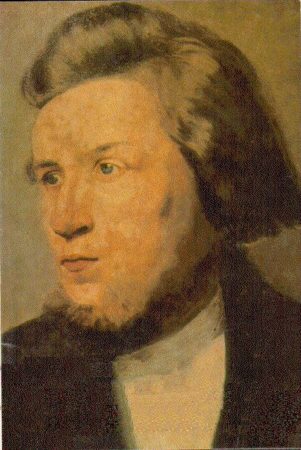
Over the next few months, I hope to describe a handful of “mileposts” in the history of the World Mission Prayer League. Mileposts are useful in times of transition, such as we have before us in our own little community. They give you an estimate of how far you have come, on the one hand. And when you take a look back, they give you a general sense of direction, too. They reveal a kind of path – like way-markers appearing above the snow, showing your way through a wood.
Our April way-marker, as it turns out, was one of the very first to appear along our path as a missionary community. It was planted in Norway, 221 years ago, in the life of a farm-boy named Hans Nielsen Hauge (1771-1824).
“The outstanding day… was April 5, 1796, when out in the field, after a long spiritual struggle, [Hauge] was born again, set free and filled with the Holy Spirit.” 1
Hauge himself described that wonderful day in April: “My heart was so uplifted to God…. It was a glory which no tongue can express…. I had a completely transformed mind, a sorrow over all sins, a burning desire that others should share the same grace, [and] a particular desire to read the Scriptures, especially Jesus’ own teachings…” 2
Hauge’s testimony is filled with living faith, the power of Scripture – and evangelical, Scandinavian Pietism. This is a spirituality that begins in personal encounter with God, by grace through faith in Jesus Christ. It advocates Christ-like living through a “transformed mind,” in response to the Savior’s dependable promises. It promotes soaking one’s life in the truths of the Bible. And it cares for souls – “that others should share the same grace.” 3
This is a spirituality that is frugal and unpretentious. It champions “the priesthood of all believers.” It aspires to common sense and usefulness, and understands every earthly vocation as opportunity for service to God. It is earnestly evangelistic. And Hauge’s spirituality was not separatist, though other Pietists sometimes were. Hauge advocated loyalty to the Lutheran church throughout his life – and living out the adventure of faith within it.
These are convictions that “cut the furrow that broke the sod for a new movement of spiritual life,” to borrow an image from Millie Tengbom, our own historiographer. 4 Long before Andrews and Lindell, Weinhardt and Carlsen – even Skrefsrud and Børresen, considered our founders – stand people like Hauge, two centuries ago. Here are “The Roots of the Vision” – that issued in us. 5
These are convictions that sometimes evoked opposition.
It is sometimes objected that Hauge did not speak with careful and scholarly theological expertise. It is careful theologians, for the most part, who point this out.
It is sometimes objected that he did not speak with pastoral balance or homiletical technique. It is balanced pastors, for the most part, who notice such things.
It is often objected that Pietism takes itself much too seriously. (This is indeed its characteristic flaw.) It is a flaw that is most evident to pastors and theologians who tend in this direction themselves.
Sometimes it is objected that Hauge’s Pietism has become anachronistic now-a-days. It represents convictions so dull and old-fashioned as to be out-of-step in today’s modern world. Who does “earnest” and “unpretentious” – in the impressive world of Facebook?
Well, very, very many, it would seem.
The Global Dictionary of Theology is an effort to identify the relevant theological trends that ripple through the global church today. 6 You will be interested to know that it features a major article treating (are you ready?) “Pietism.” 7
“[Pietism’s] centrifugal energy has had a lasting effect on Christianity in the Third World,” explains Simon Chan. “[T]he spirit of Pietism spread far and wide, so that it would be no exaggeration to say that Christianity at the grassroots level, especially in Asia and Africa, shares a deep spiritual affinity with it.” 8 Pietism may seem passé to respectable commentators in the West. Yet its themes resonate deeply elsewhere in the world.
Chan mentions five themes that resonate especially in much of the global church, that Hauge himself would recognize and applaud: a primary focus on Jesus and the cross; a clear emphasis on conversion – not as easy “triumphalism” but as “costly discipleship”; the central role given to the Bible; the priesthood of all believers; and an emphasis on “practical theology.” 9
“From the ceaseless activities of [Hans Nielsen Hauge] a national resurgence of vital, personalized Christianity emerged and spread through the realm… reaching into every level of Norwegian society.” 10
And the milepost reached our shores, too. It was planted in Minneapolis, once upon a time. Today you will find that it reaches around the world.
2 G. Everett Arden, Four Northern Lights: Men Who Shaped Scandinavian Churches (Minneapolis: Augsburg, 1964), p.57.
3 The Hauge Inner Mission Federation describes “the five things it is said that every one needs who wants to be a living Christian and a personal worker for Him: 1. A converted heart. 2. A Scripture-stored mind. 3. A love for souls. 4. A prayerful life. 5. The Holy Spirit of God.” op.cit., p.8.
4 Mildred Tengbom, The Spirit of God was Moving (Minneapolis: World Mission Prayer League, 1985), p.15. 5 ibid., pp.13ff.
6 William Dyrness and Veli-Matti Kärkkäinen, eds. (Downer’s Grove: IVP Academic, 2008)
7 Reginald Ward and Simon Chan, “Pietism,” in Dyrness and Kärkkäinen, op.cit., pp.652-657. 8 ibid., p.655.
9 Pietists are fond of saying “theologia habitus practicus est” (“theology is a practical habit”). It arises from personal experience with God in Jesus Christ, and issues in personal transformation empowered by the encounter.
10 G. Everett Arden, op.cit., p.59.
Other posts in this Mileposts series: